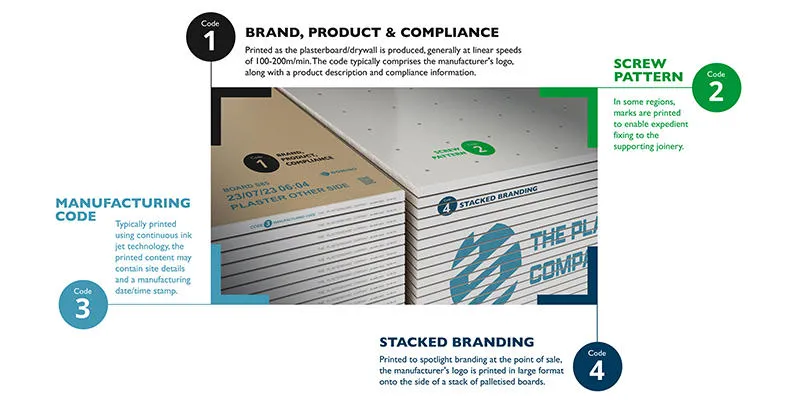High demands
As with many other industries, construction materials such as plasterboard (also known as drywall) need to be coded so that they are identifiable – typical requirements include manufacturing codes with origin, date and time of production, and batch numbers. Such codes are used for product identification and aid in traceability once a product leaves the manufacturing site. In addition, high-resolution coding of product and brand details may be desired at both a product level, and on pallets for stacked branding, i.e. logos.
Construction environments are typically very demanding and harsh, with manufacturing lines that operate at high speeds with little to no room for downtime, which can add complexity to product coding. Not only must the code itself be durable and resistant, but in order to operate effectively in a busy production environment, the coding machine must also be robust, and capable of running at very high speeds.
Achieving large area, high-resolution, high-speed coding, without compromise has historically been unattainable for many construction materials manufacturers. Typically, either code resolution, integrity, or line speed have had to be conceded to meet production demands. This no longer needs to be the case.

Domino’s Cx350i piezo inkjet printer
Domino’s industrial coding solution, the Cx350i, is a drop-on-demand (DOD), piezo inkjet (PIJ) printer that offers a combination of large-format, high-resolution printing, in a machine capable of running at industrial line speeds (up to 200m/min). The high-resolution stainless steel printhead can produce graphics and logos, text using true-type fonts (including real-time data), and machine-readable codes – in any combination, and in four color options. Individual printheads achieve 65mm print height, and multiple printheads can be combined for even greater print areas.
The size and placement of ink drops impact both print resolution and overall quality. Having inks that are perfectly compatible with the printer is key to achieving this perfect drop size and placement, which is why Domino’s Cx350i inks are specifically designed for use with this printer. In addition, Domino’s Cx350i inks are formulated using vegetable oils which contribute to the production of sustainable oils, offering a non-hazardous and environmentally responsible alternative that can support a manufacturer’s CSR goals.
Finally, the Cx350i also addresses production managers’ needs for minimal waste and downtime. The large volume ink reservoir is easily replenished, without the risk of ink spillages, and without interrupting production. Domino’s intuitive QuickStep user interface minimizes the need for extensive operator training and reduces the risk of errors. The system doesn’t require scheduled maintenance and operates without the need for factory air.
Conclusion
Gypsum board coding no longer needs to come with compromises. Domino’s Cx350i industrial printer addresses a manufacturer’s key considerations: large-area, high-resolution and durable codes, printed at optimal line speed. Moreover, it achieves these goals with in-built automation to minimize waste and error.
To learn more about how you can achieve codes without compromise, get in touch with one of our Domino experts today.